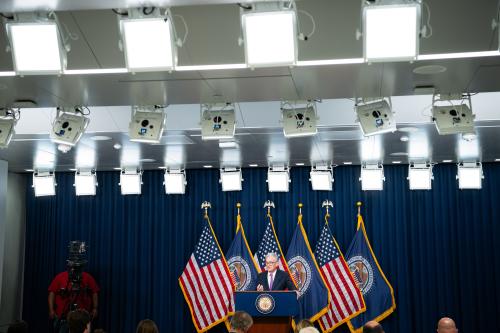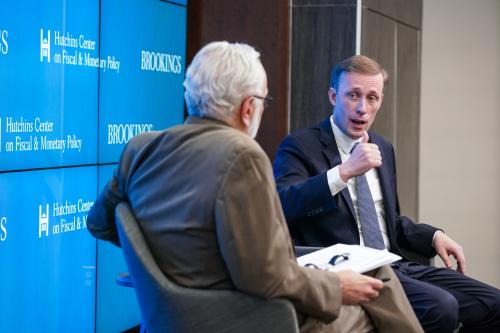For the Federal Reserve, 2015 marked a milestone: the end of seven years of holding its key interest near zero where it had been pinned since the financial crisis and recession deepened in late 2008.
In 2014, the Fed already had begun to step back from the unconventional policies by ending its purchases of Treasury bonds and mortgage-backed securities. And it had laid out the criteria for the next step—raising rates—when it had seen some further improvement in labor markets and was reasonably confident that inflation would rise to its 2 percent target over the medium term. In the view of the Federal Open Market Committee, those criteria were met by its December meeting, and the FOMC announced a quarter-percentage point basis point increase in the target range for the benchmark federal funds rate, raising it from 0-0.25 percent to 0.25-.50 percent.
Why raise rates now?
The timing and fact of any rate increase were controversial. Some skeptical observers focused on reasonably modest growth, persistent very low inflation, and globally weak growth and disinflationary pressures. They wondered: Why raise rates at all? They noted that the Federal Reserve had been consistently over-predicting growth and inflation, and they argued that waiting to confirm the emergence of rising inflation would allow the labor market to tighten further, giving greater opportunities to the unemployed and underemployed. Those pushing for an increase emphasized the rapid improvement in labor markets and low level of the unemployment rate, worrying about the risks of eventually overshooting of the inflation target and the possible distortions in financial markets of keeping rates near zero. Some of them had argued the Fed should have raised rates earlier in the year.
It was improvement in the labor market—actual and expected—and its implications for inflation down the road that led the Fed to begin the process of reducing the extraordinary degree of accommodation in monetary policy in December. Employment had been increasing at an average of around 200,000 per month in 2015, more than twice as fast as consistent with stable unemployment in the steady state, and it had shown no real sign of slowing in the fourth quarter. The unsustainable pace of job increases indicated that interest rates would need to rise at some point to prevent inflation pressures from building and threatening an overshoot of the Fed’s 2 percent target.
The level of the unemployment rate was one factor that suggested December was the time to move. Job growth had dropped the unemployment rate from 5 ¾ percent in the fourth quarter of 2014 to 5 percent in the fourth quarter of 2015. The 5 percent rate is close to the level the FOMC and many economists think is consistent with stable inflation; other measures, for example of discouraged workers and those working part time for economic reasons, suggested some slack persisted in labor markets, but those measures also had been declining appreciably over the year.
The improvement in the labor market was achieved with very moderate economic growth averaging just above 2 percent in the first three quarters of 2015. But productivity growth had been very slow—around ½ percent at an annual rate—and that, together with the effect of retiring baby boomers on labor force participation, meant that this pace of expansion in economic activity was enough to absorb new entrants into the labor force and put people back to work. This growth of GDP had been a product of good increases in demand by U.S. households and businesses, netted against a drag from international trade as increases in the foreign exchange value of the dollar and weak growth abroad dampened exports. This pattern was expected to persist in 2016, but again the net would likely be enough growth to erode the remaining slack in labor markets and cause inflation to rise toward the Fed’s 2 percent target.
Inflation was very low in 2015—barely positive—dragged down by declining energy and import prices. Core inflation measures showed a more mixed picture: the price index the Fed tracks most closely, the personal consumption expenditures (PCE) price index (excluding volatile food and energy prices), was stable at 1 ¼ percent, but the Consumer Price Index, excluding food and energy, edged higher in 2015. Measures of wage pressures also were mixed. Most of them suggested little if any acceleration, despite the low unemployment rate. But unit labor costs—a measure that combines productivity and wages—did accelerate, and rose by 3 percent from the third quarter of 2014 to the third quarter of 2015. The Fed expected inflation to pick up as energy prices stopped declining, the dollar leveled out, and as the expected tightening in the labor market pushed up costs and prices more quickly. The FOMC knows that there’s a lag between its interest-rate actions and the effects on the economy. It realizes that rates will be still quite low even after they are tightened a notch. So, in the FOMC’s judgement, waiting longer to raise rates would raise unacceptable risks that the economy would need a much steeper and disruptive set of rates increases later.
What’s next?
The Federal Reserve has been emphasizing that it’s not the first hike that’s important for the interest rates and asset prices that matter for spending and inflation, but rather its market expectations for the whole future path of rates. In that regard, Chair Yellen and many other members of the FOMC have emphasized that subsequent rate increases will depend on the implications of incoming information for the outlook for inflation and activity. But they have also noted that their projections for the economy imply that rate increases will be very gradual and come to rest at a much lower level than has been the case in past tightening cycles.
Gradual rate increases are justified in part by the low level of inflation—it is quite far from the Fed’s 2 percent target, hasn’t yet begun to increase, and when it does, is expected to rise slowly. Gradual increases are also consistent with special caution when interest rates will be near zero even after lift-off. In those circumstances, too-rapid increases that weakened the economy, or sent it back into recession, would be hard to counter with easier monetary policy; on the other hand, an unexpectedly rapid build-up in inflation pressures could be controlled with a steeper path of rate hikes.
The anticipated shallow path of rate increases also reflects expectations that the ultimate level of rates will probably be considerably lower than suggested by historical experience. This inference derives importantly from the observation that the economy hasn’t responded very strongly to near-zero nominal rates and deeply negative real rates over the past seven years. Several research studies have taken from this that at least for a while the real “neutral” rate—the rate that is consistent with the economy holding at full employment and inflation remaining stable—is around zero, or 2 percent in nominal terms. To be sure, that rate could rise over time, say as the global economy strengthens, or as potential GDP growth picks up, but that remains to be seen.
The Federal Reserve’s decision to raise rates is good news: it signals that the economy has recovered from the Great Recession and is expected to continue to grow at a moderate pace over coming years, even as rates rise slowly from the extraordinarily low level they have been since the fall of 2008. Considerable drama has surrounded the initial decision to raise rates, but drama, speculation, and uncertainty won’t be going away in 2016; it will now shift toward the next and subsequent rate increases. Stay tuned.



Commentary
Op-edAfter lift-off at the Fed, a focus on trajectory
December 16, 2015